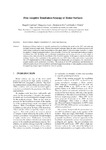Free adaptive tessellation strategy of bézier surfaces

Use este enlace para citar
http://hdl.handle.net/2183/21718Coleccións
- Investigación (FIC) [1656]
Metadatos
Mostrar o rexistro completo do ítemTítulo
Free adaptive tessellation strategy of bézier surfacesData
2014-01Cita bibliográfica
Concheiro R., Amor M., Bóo M. and Padrón E. (2014). Free Adaptive Tessellation Strategy of Bézier Surfaces.In Proceedings of the 9th International Conference on Computer Graphics Theory and Applications - Volume 1: GRAPP, (VISIGRAPP 2014) ISBN 978-989-758-002-4, pages 255-263. DOI: 10.5220/000468420255026
Resumo
[Abstract] Rendering of Bézier surfaces is currently performed by tessellating the model on the GPU and rendering the highly detailed triangle mesh. Whereas non-adaptive strategies apply the same tessellation pattern to the whole surface resulting in a uniform tessellation of the patch, adaptive approaches make it possible to reduce the number of triangles generated without a loss of quality. However, the most usual approaches to adaptive tessellation have little flexibility and do redundant computations and memory accesses, as each sample is independently evaluated in the Domain Shader of the DirectX11 pipeline. In this paper an adaptive tessellation technique based on the exploitation of the spatial coherence data within each surface is presented. The GPU implementation of this technique is simple and efficient and, as consequence, the tessellation of complex models can be performed in real-time. The analysis of the GPU performance and limitations for different adaptive degree of the tessellation performed suggest innovations in future graphics card generations for supporting a larger degree of adaptivity without a penalty.
Palabras chave
Bézier surfaces
Adaptive Tessellation
GPU
Real-Time Rendering
Adaptive Tessellation
GPU
Real-Time Rendering
Versión do editor
ISBN
978-989-758-002-4





